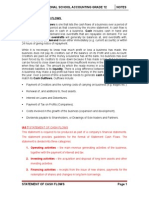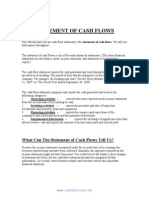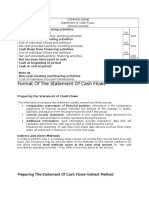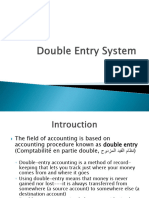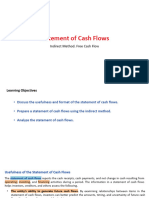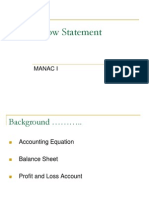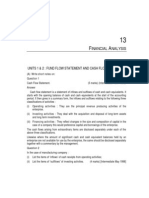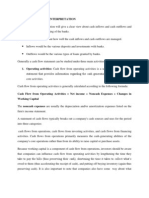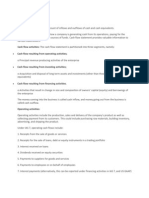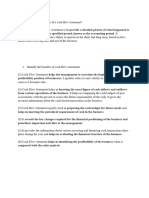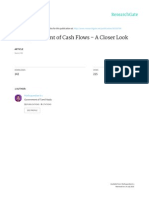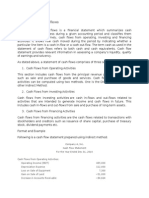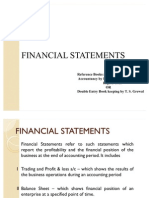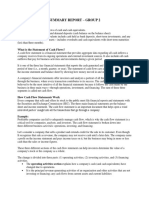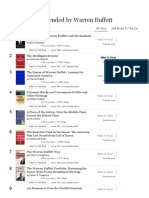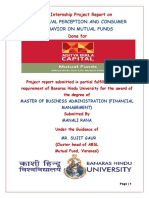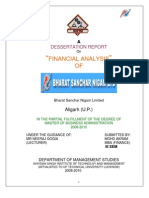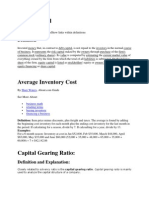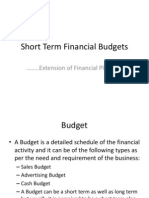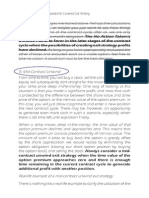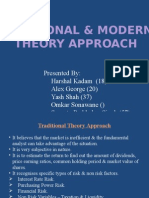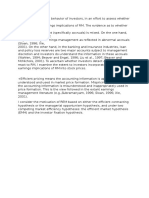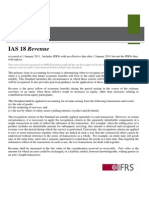CoA Debit Credit Teory
CoA Debit Credit Teory
Uploaded by
mipapirolivecomCopyright:
Available Formats
CoA Debit Credit Teory
CoA Debit Credit Teory
Uploaded by
mipapirolivecomCopyright
Available Formats
Share this document
Did you find this document useful?
Is this content inappropriate?
Copyright:
Available Formats
CoA Debit Credit Teory
CoA Debit Credit Teory
Uploaded by
mipapirolivecomCopyright:
Available Formats
BALANCE SHEET ACCOUNTS ASSETS Dr + Cr Balance Current Assets (account numbers 10000 - 16999) 10100 10200 10600 12100
12500 13100 14100 15300 Cash - Regular Checking Cash - Payroll Checking Petty Cash Fund Accounts Receivable Allowance for Doubtful Accounts Inventory Supplies Prepaid Insurance LIABILITIES Dr Cr + Balance Current Liabilities (account numbers 20000 - 24999) 20100 20200 21000 22100 23100 24500 Notes Payable - Credit Line #1 Notes Payable - Credit Line #2 Accounts Payable Wages Payable Interest Payable Unearned Revenues
Long-term Assets (account numbers 17000 - 18999) Property, Plant, and Equipment 17000 Land 17100 Buildings 17300 Equipment 17800 Vehicles 18100 Accumulated Depreciation - Buildings 18300 Accumulated Depreciation - Equipment 18800 Accumulated Depreciation - Vehicles
Long-term Liabilities (account numbers 25000 - 26999)
25100 Mortgage Loan Payable 25600 Bonds Payable 25650 Discount on Bonds Payable
STAKEHOLDER EQUITIES Dr Cr + Balance
Owner's Equity (account numbers 27000 - 29999)
27100 Mary Smith, Capital 27500 Mary Smith, Drawing
PROFIT & LOSS SHEET ACCOUNTS OPERATING EXPENSES Dr + Balance Cr OPERATING REVENUES Dr Cr + Balance
Cost of Goods Sold(account numbers 40000-49999)
41010 41022 42015 43110 COGS - Division #1, Product Line 010 COGS - Division #1, Product Line 022 COGS - Division #2, Product Line 015 COGS - Division #3, Product Line 110
Operating Revenues (account numbers 30000 - 39999)
31010 31022 32015 33110 Sales - Division #1, Product Line 010 Sales - Division #1, Product Line 022 Sales - Division #2, Product Line 015 Sales - Division #3, Product Line 110
Marketing Expenses(account numbers 50000-50999)
50100 50150 50200 50600 Marketing Dept. Salaries Marketing Dept. Payroll Taxes Marketing Dept. Supplies Marketing Dept. Telephone
Payroll Dept. Expenses (account numbers 59000 - 59999)
59100 59150 59200 59600 Payroll Dept. Salaries Payroll Dept. Payroll Taxes Payroll Dept. Supplies Payroll Dept. Telephone
Other (account numbers 90000 - 99999) Non-operating Expenses and Losses 96100 Loss on Sale of Assets
Note:Generally these types of accounts are increased with a debit: Dividends (Draws) Expenses Assets Losses
Other (account numbers 90000 - 99999) Non-operating Revenues and Gains 91800 Gain on Sale of Assets
Note:Generally these types of accounts are increased with a credit: Gains Income Revenues Liabilities Stockholders' (Owner's) Equity
The statement of cash flows is one of the main financial statements. (The other financial statements are the balance sheet, inc The cash flow statement organizes and reports the cash generated and used in the following categories: 1. Operating activities converts the items reported on the income statement from the accrual basis of accountin g to cash. reports the purchase and sale of longterm investmen ts and property, plant and equipment . reports the issuance and repurchas e of the company' s own bonds and stock and the payment of dividends.
2.
Investing activities
3.
Financing activities
4.
Supplemental information
reports the exchange of significant items that did not involve cash and reports the amount of income taxes paid and interest paid.
When an asset (other than cash) increases, the Cash account decreases. When an asset (other than cash) decreases, the Cash account increases. When a liability increases, the Cash account increases. When a liability decreases, the Cash account decreases. When owner's equity increases, the Cash account increases. When owner's equity decreases, the Cash account decreases.
Format of the Statement of Cash Flows
The statement of cash flows has four distinct sections:
1. Cash involving operating activities 2. Cash involving investing activities 3. Cash involving financing activities 4. Supplemental information.
Assuming that the cash flow statement is being prepared using the indirect method (the method used by most companies) the differences in a company's balance sheet accounts will provide much of the needed information. For example, if the statement of cash flows is for the year 2005, the balance sheet accounts at December 31, 2005 will be compared to the balance sheet accounts at December 31, 2004. The changes--or differences--in these account balances will likely be entered in one of the sections of the statement of cash flows.
Shown below is each of the four sections of the statement of cash flows, followed by a list of those balance sheet accounts which affect it.
1. Cash Provided From or Used By Operating Activities
This section of the cash flow statement reports the company's net income and then converts it from the accrual basis to the cash basis by using the changes in the balances of current asset and current liability accounts, such as: Accounts Receivable Inventory Supplies Prepaid Insurance Other Current Assets Notes Payable (generally due within one year) Accounts Payable Wages Payable
Payroll Taxes Payable Interest Payable Income Taxes Payable Unearned Revenues Other Current Liabilities
In addition to using the changes in current assets and current liabilities, depreciation and the gains/losses on the sale of long-term assets are removed so that the income statement net income is converted from the accrual basis to cash.
2. Cash Provided From or Used By Investing Activities
This section of the cash flow statement reports changes in the balances of long-term asset accounts, such as: Long-term Investments Land Buildings Equipment Furniture & Fixtures Vehicles
In short, investing activities involve the purchase and/or sale of long-term investments and property, plant, and equipment.
3. Cash Provided From or Used By Financing Activities
This section of the cash flow statement reports changes in balances of the long-term liability and stockholders' equity accounts, such as:
Notes Payable (generally due after one year) Bonds Payable Deferred Income Taxes Preferred Stock Paid-in Capital in Excess of Par-Preferred Stock Common Stock Paid-in Capital in Excess of Par-Common Stock Paid-in Capital from Treasury Stock Retained Earnings Treasury Stock
In short, financing activities involve the issuance and/or the repurchase of a company's own bonds or stock. Dividend payments are also reported in this section.
4. Supplemental Information
This section of the cash flow statement discloses the amount of interest and income taxes paid. Also reported are significant exchanges not involving cash. For example, the exchange of company stock for company bonds would be reported in this section.
Where To Enter The Balance Sheet Changes
Take a look at the summary below--it shows where the changes in balance sheet accounts should be entered on your statement of cash flows: A change in this ...is reported in this section of the cash flow statement
balance sheet category
Current Assets* Current Liabilities Long-term Assets Long-term Liabilities Stockholders' Equity
Operating Activities Operating Activities Investing Activities Financing Activities Financing Activities
*This refers to current assets other than Cash.
Adjustments Within The Operating Activities Section
When we use the indirect method to prepare a statement of cash flows we begin with the net income figure from the company's income statement as our starting point. We then make adjustments to that figure to arrive at the cash amount.
If all of a company's revenues were cash sales (no credit sales), and if the company paid out cash for all of its expenses, then net income would equal the cash from operating activities. However, since some of the revenues and expenses on the income statement were not cash transactions, we must include depreciation, gain or losses on sales of assets, and the changes in current assets and current liabilities. These adjustments will be illustrated in the hypothetical story presented in Part 2.
ments are the balance sheet, income statement, and statement of stockholders' equity.)
You might also like
- (Camp, 2002) Venture Capital Due Diligence PDFDocument267 pages(Camp, 2002) Venture Capital Due Diligence PDFlalall100% (4)
- Intermediate Accounting 1: a QuickStudy Digital Reference GuideFrom EverandIntermediate Accounting 1: a QuickStudy Digital Reference GuideNo ratings yet
- Cash Flow Analysis PresentationDocument44 pagesCash Flow Analysis Presentationkojo2kg100% (1)
- A Brief History of Venture CapitalDocument2 pagesA Brief History of Venture CapitalShilpi BhadoriyaNo ratings yet
- Finacial StatementDocument14 pagesFinacial StatementRaissa Almojuela Del ValleNo ratings yet
- Statement of Change in Financial Position-5Document32 pagesStatement of Change in Financial Position-5Amit SinghNo ratings yet
- Cash Flow Statement Wit SumDocument27 pagesCash Flow Statement Wit SumSunay KhaireNo ratings yet
- Cima F1 Chapter 4Document20 pagesCima F1 Chapter 4MichelaRosignoli100% (1)
- Importance of Financial StatementsDocument10 pagesImportance of Financial StatementsAmrit TejaniNo ratings yet
- Lecture 3 Week 3 PPT 3Document39 pagesLecture 3 Week 3 PPT 3Li Lin100% (1)
- Who Cares About A Cash Flow StatementDocument5 pagesWho Cares About A Cash Flow StatementAdnan SajidNo ratings yet
- Cash FlowDocument14 pagesCash FlowJoven BaisaNo ratings yet
- Alwadi International School Accounting Grade 12 Notes: Statement of Cash FlowsDocument14 pagesAlwadi International School Accounting Grade 12 Notes: Statement of Cash FlowsFarrukhsgNo ratings yet
- Introduction Cash FlowDocument10 pagesIntroduction Cash FlowAmrit TejaniNo ratings yet
- Statement of Cash FlowsDocument35 pagesStatement of Cash Flowsonthelinealways100% (4)
- Cash Flow StaementDocument14 pagesCash Flow StaementKhizar Hayat JiskaniNo ratings yet
- Lecture 5. Statement of Cashflows (IAS7) (Presentation) - 1Document22 pagesLecture 5. Statement of Cashflows (IAS7) (Presentation) - 1masawitalent0410No ratings yet
- What Are Operating Activities?: Purpose of The Cash Flow StatementDocument4 pagesWhat Are Operating Activities?: Purpose of The Cash Flow StatementMitch MinglanaNo ratings yet
- Cash Flow StatementDocument10 pagesCash Flow Statementhitesh26881No ratings yet
- FIN3702 SummaryDocument26 pagesFIN3702 SummaryQuentin SchwartzNo ratings yet
- ACC101-Chapter12new 000 PDFDocument26 pagesACC101-Chapter12new 000 PDFShibasundar Behera100% (1)
- Understanding Cash Flow StatementDocument3 pagesUnderstanding Cash Flow StatementImran IdrisNo ratings yet
- Cash FlowsDocument26 pagesCash Flowsvickyprimus100% (1)
- FFS and CFSDocument28 pagesFFS and CFSAnuj DhamaNo ratings yet
- Cash Flow Statement: Position of A Firm. Cash and Relevant Terms As Per AS-3 (Revised)Document17 pagesCash Flow Statement: Position of A Firm. Cash and Relevant Terms As Per AS-3 (Revised)Jebby VargheseNo ratings yet
- Wlof Hsac Gnitarepo Gncinfina: Jumble LettersDocument23 pagesWlof Hsac Gnitarepo Gncinfina: Jumble LettersAce Soleil RiegoNo ratings yet
- Cash Flow AnalysisDocument15 pagesCash Flow AnalysisElvie Abulencia-BagsicNo ratings yet
- Cash Flow StatementDocument4 pagesCash Flow Statementmajaykumar1349810No ratings yet
- 12.2 - Cash Flows From Operating Activities: Treatment of Interest ReceivedDocument9 pages12.2 - Cash Flows From Operating Activities: Treatment of Interest ReceivedSrikiran RajNo ratings yet
- Pfa0064 - Topic 9Document18 pagesPfa0064 - Topic 9Jeyaletchumy Nava RatinamNo ratings yet
- CfsDocument19 pagesCfsAakash ChhariaNo ratings yet
- Chapter 13 PowerPointDocument89 pagesChapter 13 PowerPointcheuleee100% (1)
- Financial Statements, Cash Flows, and TaxesDocument31 pagesFinancial Statements, Cash Flows, and Taxesjoanabud100% (1)
- Accounting Standard (AS) - 3: Cash Flow StatementsDocument26 pagesAccounting Standard (AS) - 3: Cash Flow StatementsJonathan BarretoNo ratings yet
- Statement of Cash Flows Chapter # 10Document22 pagesStatement of Cash Flows Chapter # 10Fahad BataviaNo ratings yet
- Preparing The Statement of Cash Flows-Indirect MethodDocument11 pagesPreparing The Statement of Cash Flows-Indirect MethodMelvin ZefanyaNo ratings yet
- Double Entry SystemDocument26 pagesDouble Entry SystemMohammad SahiliNo ratings yet
- Understanding Financial StatementsDocument32 pagesUnderstanding Financial StatementsAravinda RuwanNo ratings yet
- PPT - Cashflow Statement + TAccount ApproachDocument41 pagesPPT - Cashflow Statement + TAccount ApproachblairelallainaNo ratings yet
- Cash Flow StatementDocument35 pagesCash Flow StatementShiv Shankar Kumar100% (1)
- Cash Flow StatementDocument57 pagesCash Flow StatementSurabhi GuptaNo ratings yet
- Cash Flow Statements Exercises and AnswersDocument39 pagesCash Flow Statements Exercises and Answersszn189% (9)
- Calculating Cash Flow From Operating ExpensesDocument15 pagesCalculating Cash Flow From Operating Expenseskyungsoo100% (1)
- Ias 7Document6 pagesIas 7Nicolé van StadenNo ratings yet
- Data Analysis and InterpretationDocument11 pagesData Analysis and InterpretationRiya Agarwal80% (5)
- Cash FlowDocument4 pagesCash FlowHrituparna_Pau_2988No ratings yet
- Acc201 Su6Document15 pagesAcc201 Su6Gwyneth LimNo ratings yet
- Cash Flow StatementDocument11 pagesCash Flow StatementTagele gashawNo ratings yet
- IAS 7, Statement of Cash Flows - A Closer Look: ArticleDocument10 pagesIAS 7, Statement of Cash Flows - A Closer Look: ArticlevcdsvcdsvsdfNo ratings yet
- Statement of Cash Flows: Direct Method Indirect MethodDocument5 pagesStatement of Cash Flows: Direct Method Indirect MethodeswarlalbkNo ratings yet
- Budgeting and Finance CourseDocument64 pagesBudgeting and Finance CourseRobert DeliaNo ratings yet
- 1.1 Balance Sheet: Balance Sheet Income Statement Cash Flow Statement Statement of Stockholders' EquityDocument5 pages1.1 Balance Sheet: Balance Sheet Income Statement Cash Flow Statement Statement of Stockholders' EquityKamran ShahNo ratings yet
- Financial StatementsDocument20 pagesFinancial StatementsOmnath Bihari100% (1)
- Fabm ReviewerDocument15 pagesFabm ReviewerycotjohnramernNo ratings yet
- Summary Report - Group 2: Definition of TermsDocument8 pagesSummary Report - Group 2: Definition of TermsRigor Salonga BaldemosNo ratings yet
- Profit and Loss AccountDocument5 pagesProfit and Loss AccountLanston PintoNo ratings yet
- Mid Term TopicsDocument10 pagesMid Term TopicsТемирлан АльпиевNo ratings yet
- IAS-7 S C F: Tatement of ASH LowsDocument11 pagesIAS-7 S C F: Tatement of ASH LowsAsim NazirNo ratings yet
- IAS-7 S C F: Tatement of ASH LowsDocument11 pagesIAS-7 S C F: Tatement of ASH LowsLauren WebbNo ratings yet
- Financial Accounting - Want to Become Financial Accountant in 30 Days?From EverandFinancial Accounting - Want to Become Financial Accountant in 30 Days?Rating: 3.5 out of 5 stars3.5/5 (2)
- Audit of Shareholders EquityDocument5 pagesAudit of Shareholders EquityShane KimNo ratings yet
- Goodreads - Books Recommended by Warren Buffett (30 Books)Document4 pagesGoodreads - Books Recommended by Warren Buffett (30 Books)Achint KumarNo ratings yet
- Takeovers and Trends in Takeover ActivitiesDocument11 pagesTakeovers and Trends in Takeover Activitiesindianbhartiya1990No ratings yet
- Dell Computer Corporation: AssetsDocument20 pagesDell Computer Corporation: AssetsAniqa AshrafNo ratings yet
- Consumer Behavior On Mutual FundsDocument57 pagesConsumer Behavior On Mutual FundsManali Rana50% (2)
- BSNL ReportDocument84 pagesBSNL ReportASHRAFI7860100% (7)
- Ethics Must Be Global, Not LocalDocument2 pagesEthics Must Be Global, Not LocalfayezahammadNo ratings yet
- Pacilio Securtiy Service Accounting EquationDocument11 pagesPacilio Securtiy Service Accounting EquationKailash KumarNo ratings yet
- Chapter 2Document15 pagesChapter 2Megan Ho100% (2)
- Financial Ananlysis of Dabur India LimitedDocument69 pagesFinancial Ananlysis of Dabur India Limitedk_abhishek91No ratings yet
- PTCL's Privatization: The Biggest Financial Scam in Pakistan's History?Document4 pagesPTCL's Privatization: The Biggest Financial Scam in Pakistan's History?ash haq100% (1)
- Equity Capital: Shari WatersDocument6 pagesEquity Capital: Shari WatersMirza ShoaibbaigNo ratings yet
- CF Assignment Maruti SuzukiDocument6 pagesCF Assignment Maruti SuzukiRuchika SinghNo ratings yet
- Short Term Financial Budgets and Corporate FinanceDocument19 pagesShort Term Financial Budgets and Corporate FinanceAli AkberNo ratings yet
- Ellman Encyclopedia - Mid-Contract Unwind Exit Strategy Pgs 264-271Document8 pagesEllman Encyclopedia - Mid-Contract Unwind Exit Strategy Pgs 264-271Alan Ellman100% (2)
- Roe To CfroiDocument30 pagesRoe To CfroiSyifa034100% (2)
- Traditional & Modern Theory ApproachDocument12 pagesTraditional & Modern Theory Approachyash shah78% (9)
- MacareanaDocument1 pageMacareanaNivesh LallbahadoorNo ratings yet
- Jean Marie Part 1Document5 pagesJean Marie Part 1ekramcalNo ratings yet
- IAS 18 Revenue: Technical SummaryDocument2 pagesIAS 18 Revenue: Technical SummaryKyleRodSimpsonNo ratings yet
- Corporate Governance ReportDocument41 pagesCorporate Governance Reportmuhammad aliNo ratings yet
- Bombay DyeingDocument222 pagesBombay DyeingReTHINK INDIANo ratings yet
- MGMT 30A: Practice FinalDocument18 pagesMGMT 30A: Practice FinalFUSION AcademicsNo ratings yet
- Fmi Assignment #8: Ind - Ps - Ps - A1 McqsDocument4 pagesFmi Assignment #8: Ind - Ps - Ps - A1 McqsAditi RawatNo ratings yet
- BMFM 33141 Group Assignment (Case Study) March 2022Document3 pagesBMFM 33141 Group Assignment (Case Study) March 2022Woo JohnsonNo ratings yet
- Problems Problems 15-1 (IAA)Document6 pagesProblems Problems 15-1 (IAA)sarahNo ratings yet
- Annual Report Roti 2011Document122 pagesAnnual Report Roti 2011StefanyNo ratings yet
- Acc 231 CH 1 Flash CardsDocument4 pagesAcc 231 CH 1 Flash CardsAnonymous Ax1gYcVnyHNo ratings yet












